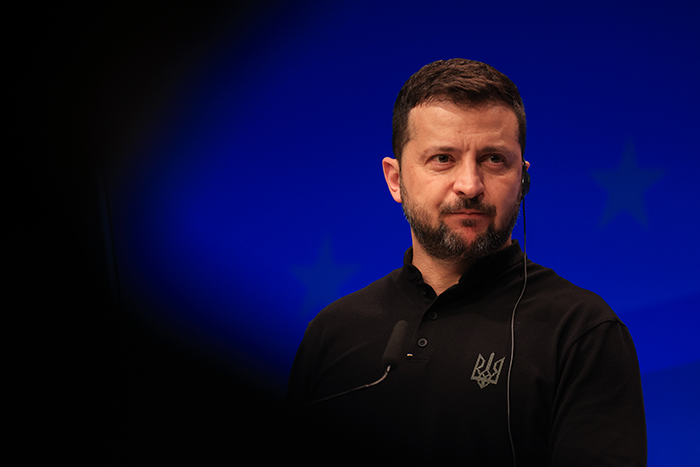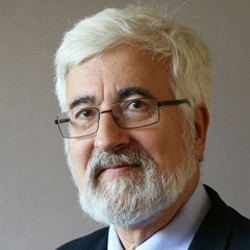Interviews
19 June 2024
Ukraine Peace Conference: Modest Progress for Kyiv

Last weekend, in Switzerland, 90 heads of state gathered around the Ukrainian president for a high-level peace conference on Ukraine. Although China and Russia were absent from these negotiations, the conference concluded with 79 countries signing a communiqué based on the three points President Volodymyr Zelensky wished to address. Despite some progress, Ukraine’s strategy of rallying the Global South failed, as evidenced by the fact that no BRICS+ member signed the final communiqué. What can be taken away from this peace conference? What are the military prospects of this conflict? How is Russia’s “war economy” holding up? Answers from Jean de Gliniasty, former French ambassador to Russia, research director at IRIS, and specialist in Russian affairs.
A high-level conference for peace in Ukraine was held this weekend in Switzerland, bringing together nearly 90 heads of state, representatives of international organisations, and Ukrainian President Volodymyr Zelensky. What were the summit’s objectives ? Did Ukraine achieve progress or secure any guarantees ?
President Volodymyr Zelensky himself had already acknowledged the limits of the exercise. It was primarily about reinforcing Ukraine’s diplomatic position in the event – still unlikely – of negotiations. The term “Peace Summit” is, however, inadequate since one of the belligerents, Russia, was not invited. Ukraine also had to scale back its ambitions in order to attract as many “Global South” states as possible. It was out of the question to have them endorse the ten-point plan Zelensky had presented at the G20 Summit in Bali in November 2022, including the withdrawal of Russian troops to the 2014 borders, financial compensation and reparations for Ukraine, and prosecution of Russian leaders.
To gain support from Global South countries for the final communiqué, only three of Zelensky’s original points were placed on the agenda: nuclear security – especially regarding the Zaporizhzhia power plant – food security and Ukraine’s ability to export grain, and the return of prisoners and Ukrainian children taken to Russia. Within these limits, and with Switzerland’s backing, Ukraine secured some notable results. Over one hundred delegations were present, and the final communiqué, covering the three topics discussed and reaffirming the need to respect the territorial integrity and sovereignty of all states, including Ukraine, was signed by 79 countries. However, no BRICS member state agreed to play along – either boycotting the meeting or refusing to endorse the communiqué, despite it being watered down to attract their support. The hoped-for rallying of the Global South to Ukraine’s cause did not materialise.
In contrast, Russia countered with its own peace plan, putting forward its demands: withdrawal of Ukrainian forces from the four regions annexed by Russia (not all of which are fully occupied – such as Zaporizhzhia, Kherson and Donetsk…) and Kyiv’s neutrality in relation to NATO. Described as a call for capitulation, notably by France, this plan nonetheless constitutes the first clear expression of Russian demands, moving beyond vague references to the “denazification” of Ukraine. Everyone now recognises that the next step will necessarily be a conference involving Russia, and many contenders are eager to host it. But for now, war continues.
As the conflict drags on and Ukrainian forces face significant challenges, what is the current situation on the front line ? What are the military prospects, particularly in the Black Sea where fighting is intensifying ?
The more time passes, the more Ukraine’s position solidifies, and the less likely it is that Russia will achieve a major breakthrough. Nevertheless, the Russians continue to gain ground, village by village, and the imbalance in troop numbers will remain permanently to Kyiv’s disadvantage. Putin has announced that he now has 700,000 troops in Ukraine, while Ukraine is struggling to enforce its mobilisation law, which was passed too late in any case. As a result, a decisive Russian breakthrough is becoming increasingly unlikely, though it cannot be completely ruled out.
In the Black Sea, Ukraine has won the battle in the sense that Russia has lost maritime control. In this enclosed sea, the range of Ukrainian land-based missiles and drones is sufficient to prevent any major naval operations. The maritime space is effectively neutralised, and bombardments of Crimea are now almost daily. If the war continues, it is not impossible that Russia will attempt to seize control of the entire coastline to regain naval dominance – but this would require taking Odessa, which would be difficult and costly, and would likely provoke a strong reaction from the West, which fears destabilisation in the Balkans.
How is Russia’s war effort and war economy organised? Is the “special military operation”, as it is called in Russia, still supported by the population ?
Russia has geared itself up for a prolonged war. The appointment of a new Minister of Defence, Andrei Belousov – known for his honesty and managerial skills – the purging of generals and deputy ministers for various reasons or pretexts (corruption, incompetence, internal reshuffling…), and the mobilisation of the military-industrial complex, have established what can be described as a “war economy”, with military spending accounting for 7% of the national budget.
However, aside from inflation (over 8%), labour shortages, and the resulting wage increases, life continues as usual in major cities, with no requisitioning in the civilian sector, save for a few exceptions. High military salaries, substantial enlistment bonuses, death benefits for families, medical care for the wounded, and special treatment or honours for veterans (a novelty in Russia) are currently enough to placate families of soldiers, who are generally from modest backgrounds.
Above all, the narrative of a “collective West” besieging and seeking to destroy Russia has taken hold across the population, at all levels. While most people would prefer peace, feelings of “legitimacy” and patriotism work in favour of the authorities, who face no domestic pressure to end the war.
Still, some storm clouds are gathering. Gas exports have declined, and oil – the main revenue source – could soon face new sanctions, including on liquefied natural gas, which has so far been exempt. Russia has already drawn on half of its sovereign wealth fund and raised taxes on individuals and businesses to balance a 2024 budget, 40% of which is allocated to defence. In 2023, Russia’s trade surplus plummeted to $50 billion from $238 billion in 2022 – the latter having been bolstered by a surge in gas prices.
Labour market tensions, resurgent inflation, and a 16% interest rate hampering investment are all obstacles. Still, after recording 3.6% GDP growth in 2023, Russian authorities recently revised their 2024 growth forecast upwards to 2.8%. Bolstered by the “war economy” and managed competently, the state of Russia’s economy and the prevailing public sentiment continue to provide the Kremlin with significant leeway to pursue the war.

